Our Logo Translation
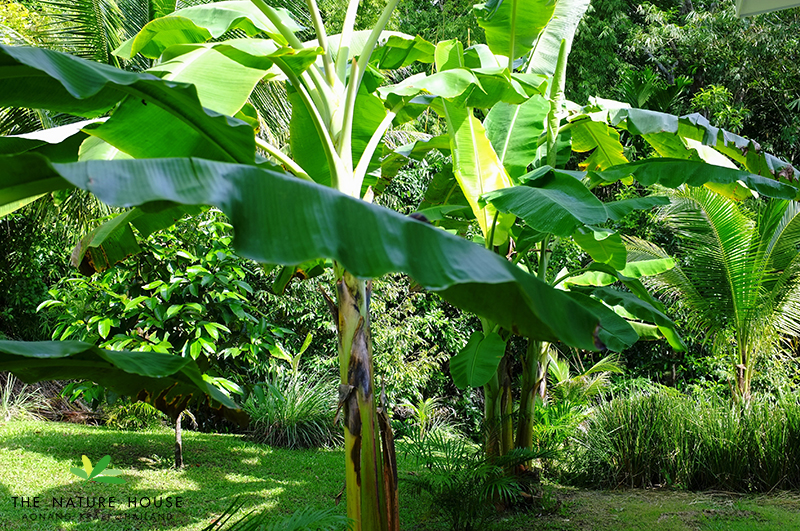
Bananas are the inspiration for our logo. They grow and occur naturally in our environment here in The Nature House. After that we propagation of a banana tree until now. In addition to their natural beauty, the banana has many health benefits.
When I was young my mother said to me when we plant the banana tree close to other trees - in this way they are preserve and offer moisture to their neighbors.
The same with our Mission! We will take care all of you like a member of our own family.
Our Fruits
Banana
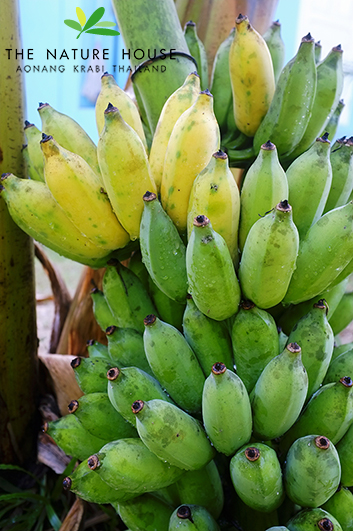
Banana is the most popular fresh fruit in all over the world and its name comes from the Arabic word 'banan', which means finger. The scientific name of Banana is Musa acuminata and Musa balbisiana. But the old scientific names of banana are Musa sapientum and Musa paradisiacal. It is not used longer. Bananas are rich source carbohydrates and potassium. They are the first choice by athletics due to its high energy giving capability. The funny thing to notice about banana is its shape (like an arc) which makes its appearance appealing.
Varieties: They come in colors say, green, yellow, purple and red. Most of the varieties are perennial (grown throughout the year). They are native to tropical southeast asis, but now are grown almost in all places. They are known as either "Dessert" bananas (when fully ripe) or cooking bananas
Banana plant can be found very easily in one's yard or gardens as they are very easy to cultivate and it is the largest herbaceous flowering plant. It can grow up to 6 to 6.7 meters (20 to 24.9 ft) tall and its leaves can grow up to 2.7 meters (8.9 ft) long and 60 cm (2.0 ft) wide.
Single Banana of average 125 grams has about 75% of water and 25% of waterless substance. It has protective external layer called peel or skin and many threads around between the peel and internal layer. Its seed is like tiny black specks present in the interior portion of the fruit.
Medicinal uses of Banana:
Banana can be used to avoid the following major diseases,
• Anemia: Because of high iron content in banana, it is very useful for anemia sufferer
• Blood Pressure: Banana has high potassium and low salt content, helpful to hit blood pressure.
• Memory loss: Recent research report shows that the potassium packed fruit can helpful to boost the memory. So Banana is very useful to students during their exams.
• Depression: According to MIND survey amongst people who suffered from depression, many felt much recovered after eating a banana. This is because banana has tryptophan. The tryptophan is a protein converts your body into serotonin that make you relax, improve your mood and make you feel happier.
• Hangovers: Drinking banana milkshake sweetened with honey is one of the easiest ways to cure a hangover. Normally the banana has the power to calms the stomach, honey builds up depleted blood sugar levels and milk soothes and re-hydrates your system.
• Heartburn: Banana has a natural antacid which has the power to give relief from Heartburn.
• Morning Sickness: Taking bananas between meals helpful to maintain blood sugar levels up and keep you away from morning sickness.
• Mosquito bites: Rubbing with inner side of the banana skin has the power to reduce the swelling and irritation caused by mosquito.
• Nerves: Because of high vitamin B, banana helps to calm the nervous system.
• Seasonal Affective Disorder (SAD): Banana is very useful for SAD sufferers because they have the natural mood enhancer, trypotophan.
• Strokes: According to the research “The New England Journal of Medicine", the banana cut the risk of death caused by strokes by as much as 40%.
• Temperature control: Banana is very useful for pregnant women to ensure their baby is born with a cool temperature.
• Ulcers: The banana can be used as the dietary food against intestinal disorders because of its soft texture and smoothness.
• Warts: Take a part of banana skin and keep it on the wart area with the yellow side out.
Rambutan
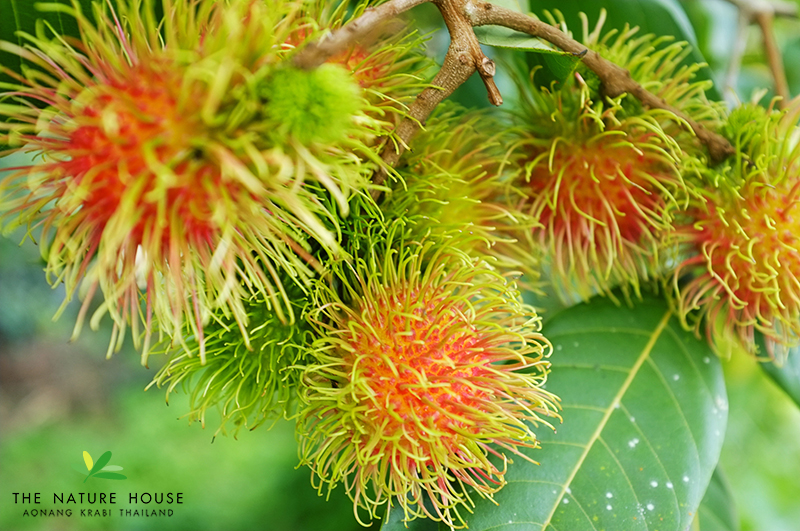
Rambutans are grown in Thailand as well as Malaysia, Indonesia, the Philippines, and Australia. Most rambutans are red, but in Malaysia a smaller, yellow rambutan can also be found. Rambutans grow in clusters on evergreen trees, and are hairy-looking exotic wonders!
The name rambutan is derived from the Malay/Indonesian word rambutan, meaning “hairy”rambut the word for “hair” in both languages, a reference to the numerous hairy protuberances of the fruit, together with the noun-building suffix -an.In Vietnam, it is called chôm chôm (meaning “messy hair”) due to the spines covering the fruit’s skin.
It is an evergreen tree growing to a height of 12–20 m. The leaves are alternate, 10–30 cm long, pinnate, with 3–11 leaflets, each leaflet 5–15 cm wide and 3–10 cm broad, with an entire margin. The flowers are small, 2.5–5 mm, apetalous, discoidal, and borne in erect terminal panicles 15–30 cm wide.
trees are either male (producing only staminate flowers and, hence, produce no fruit), female (producing flowers that are only functionally female), or hermaphroditic (producing flowers that are female with a small percentage of male flowers).
The fruit is a round to oval drupe 3–6 cm (rarely to 8 cm) tall and 3–4 cm broad, borne in a loose pendant cluster of 10–20 together. The leathery skin is reddish (rarely orange or yellow), and covered with fleshy pliable spines, hence the name rambutan, derived from the Malay word rambut, which means hairs. The fruit flesh is translucent, whitish or very pale pink, with a sweet, mildly acidic flavor very reminiscent of grapes.
The single seed is glossy brown, 1–1.3 cm, with a white basal scar.Soft and crunchy, the seeds are mildly poisonous when raw, but may be cooked and eaten. In fact the peeled fruits can be cooked and eaten, first the grape-like aril, then the nutty seed, with no waste.
Health benefits of Rambutan
Rambutan fruit contains carbohydrate, protein, fat, phosphorus, iron, calcium and vitamin C. Coat tannin of fruit and Leaves contain saponin. The seeds always contain fat and polifenol. Skin and stem contains tannin, saponin, flavonida, pectic substances, and iron.. Rambutans roots, bark, and leaves have various uses in the production of dyes and drugs. Part of this plant can be used as a medicinal fruit and have benefits for health such as
•Reduce Body Fat
•Make skin softer
•Hair care
•Treat dysentery
•Treat diabetes
Santol
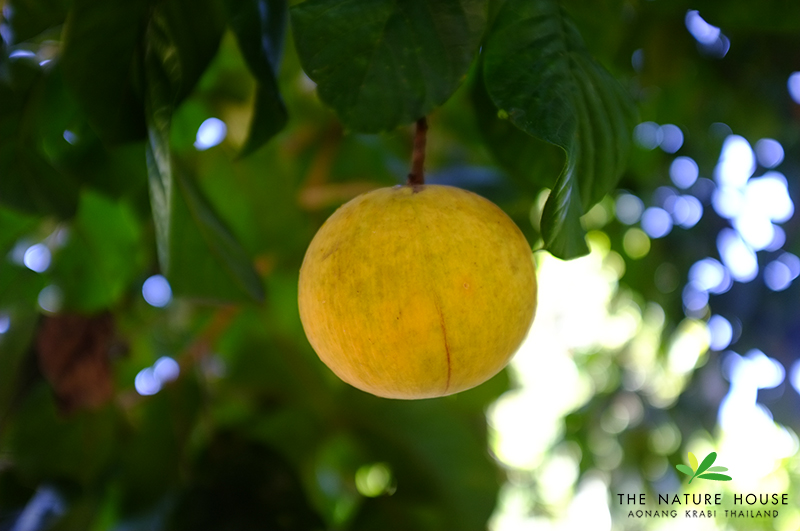
The Santol fruit tissue is mostly sub-acid or sour in nature. When the fruit is unripe, this tissue is even more sour. Santols are also used to make marmalade.
The external pulp of the santol fruit can be awfully inedible and harsh when the fruit is in an unripe but miraculously transforms itself into a sweet taste and tasty ripe specimen. Average fruits are bigger than a softball shape and the flesh and seeds were incredibly sweet/tart and gravely habit forming. The youthful fruits are candied. The ripen fruits have a vinous taste.
Medicinal Uses of Santol
Several parts of the santol plant have anti-inflammatory properties. They are used for the treatment of diarrhea and dysentery. These are also used vinegar and mixture of water as a carminative. It is also used for tanning fishing nets. The aromatic, caustic root is also a potent remedy for diarrhea. The root is a tonic for stomachic and antispasmodic.
Longkong

Longkong is a tropical fruit, grown mostly in southern of Thailand, Malaysia, Indonesia and the Philippines. It’s in the same species of langsat. In fact, they are very similar, except langsat’s skin is more yellow, smoother, and its seeds are more bitter. Longkong used to be an expensive fruit, however, in recent years, its price came down. Now it’s very affordable.
Longkong has abundant of vitamin B, phosphorus, aas well as some vitamin C because it’s sour. After peeled out the skin, you could see translucent meat inside. The meat is sweet, tasted little sour, soft, and slimy. If you find small seeds inside, you can also eat them. But the bigger the seeds, the bitter they taste. Buying longkong is somewhat like buying lottery. Sometimes you get a very sweet one, sometimes very sour.
Jackfruit
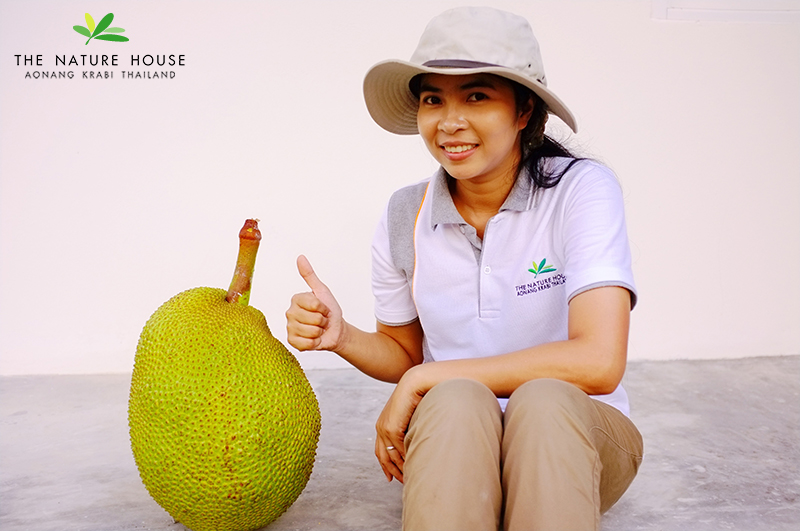
Enormous and prickly on the outside, jackfruit looks somewhat like durian (though jackfruit is usually even larger). Once a jackfruit is cracked open, what you will find inside are pods or “bulbs”. Often referred to as the seeds, these bulbs are actually a kind of fleshy covering for the true seeds or pits, which are round and dark like chesnuts. The fleshy part (the “bulb”) can be eaten as is, or cut up and cooked. When unripe (green), it is remarkably similar in texture to chicken, making jackfruit an excellent vegetarian substitute for meat. In fact, canned jackfruit (in brine) is sometimes referred to as “vegetable meat”.
Jackfruit can also be purchased frozen, dried, or canned either in brine (usually unripe) or in syrup (ripe and sweet). If using fresh jackfruit, it’s a good idea to oil your knife and hands first before cutting, as the fruit is very sticky.
Jackfruit contains many vitamins and minerals, and offers numerous health benefits. The fruit’s isoflavones, antioxidants, and phytonutrients mean that jackfruit has cancer-fighting properties. It is also known to help cure ulcers and indigestion.
Benefits of Jackfruit Seeds
The seeds have around 135 kcal/ 100 gms. It is a rich source of complex carbohydrate, dietary fiber, vitamins like vitamin A, C and certain B vitamins, and minerals like calcium, zinc, and phosphorous with high nutrition benefit in a seed.
Jackfruit seed contain lignans, isoflavones, saponins, that are called phytonutrients and their health benefits are wide-ranging from anti-cancer to antihypertensive, anti-ageing, antioxidant, anti-ulcer, etc.
Boiled Jackfruit seeds are very tasty and nutritious snacks to eat. Jackfruit seeds, which always taste like chestnuts which appeal to all tastes, may be boiled or roasted and eaten, or boiled and preserved in syrup like chestnuts.
Coconut
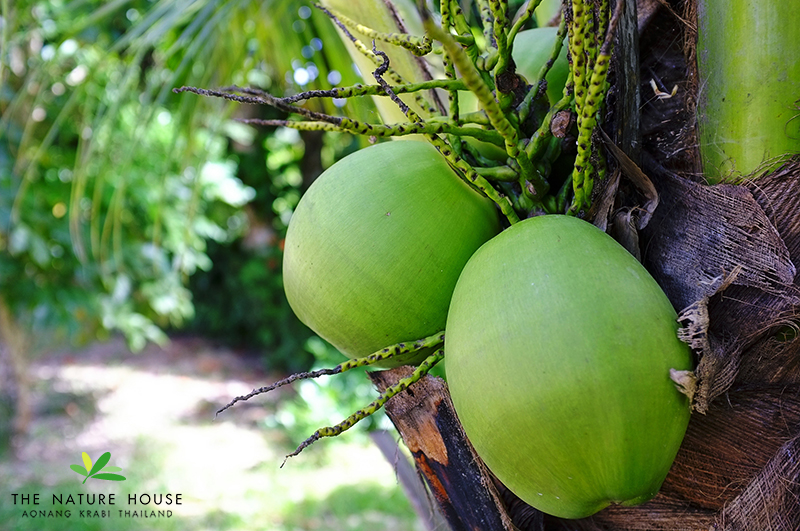
Coconut fruit is a drupe, not a true nut.Like other fruits, it has three layers: the exocarp, mesocarp, and endocarp. The exocarp and mesocarp make up the “husk” of the coconut. Coconuts sold in the shops of nontropical countries often have had the exocarp (outermost layer) removed. The mesocarp is composed of a fiber, called coir, which has many traditional and commercial uses. The shell has three germination pores (stoma) or “eyes” that are clearly visible on its outside surface once the husk is removed. A full-sized coconut weighs about 1.44 kilograms (3.2 lb). It takes around 6000 full-grown coconuts to produce a tonne of copra.
Coconut is a large palm, growing up to 30 meters (98 ft) tall, with pinnate leaves 4–6 meters (13–20 ft) long, and pinnae 60–90 cm long; old leaves break away cleanly, leaving the trunk smooth. Coconuts are generally classified into two general types: tall and dwarf. On very fertile land, a tall coconut palm tree can yield up to 75 fruits per year, but more often yields less than 30 mainly due to poor cultural practices. In recent years, improvements in cultivation practices and breeding has produced coconut trees that can yield more.
Unlike some other plants, the palm tree has neither a tap root nor root hairs, but has a fibrous root system.
Found throughout the tropic and subtropic area, the coconut is known for its great versatility as seen in the many domestic, commercial, and industrial uses of its different parts. Coconuts are part of the daily diet of many people. Coconuts are different from any other fruits because they contain a large quantity of “water” and when immature they are known as tender-nuts or jelly-nuts and may be harvested for drinking. When mature they still contain some water and can be used as seed nuts or processed to give oil from the kernel, charcoal from the hard shell and coir from the fibrous husk. The endosperm is initially in its nuclear phase suspended within the coconut water. As development continues, cellular layers of endosperm deposit along the walls of the coconut, becoming the edible coconut “flesh”.When dried, the coconut flesh is called copra. The oil and milk derived from it are commonly used in cooking and frying; coconut oil is also widely used in soaps and cosmetics. The clear liquid coconut water within is a refreshing drink. The husks and leaves can be used as material to make a variety of products for furnishing and decorating. It also has cultural and religious significance in many societies that use it.
Champada
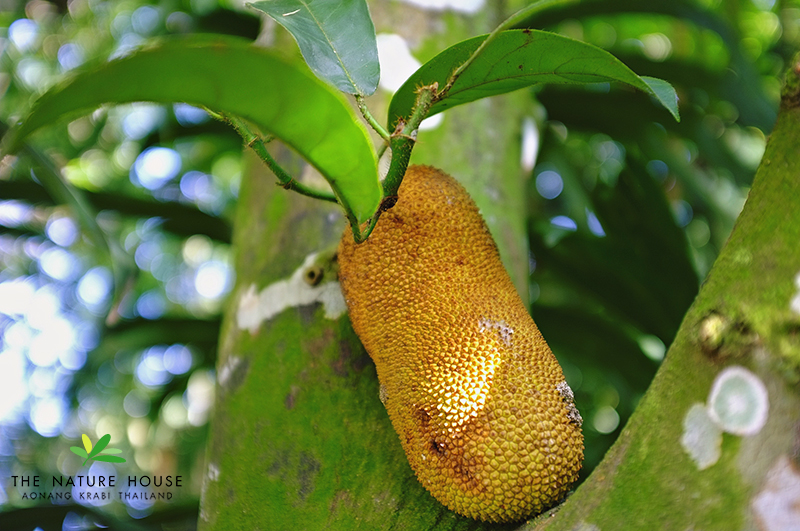
This fruit closely resembles jackfruit. However, its fruits are smaller in size than those of jackfruit and the tree has long brown hairs on twigs as well as leaves. Champada is very popular in Southern Thailand.
Fruit is a syncarp, cylindrical to almost globose, 20-35 × 10-15 cm, yellowish, brownish, or orange-green, smelling strongly at maturity.
Seeds ellipsoid to oblong, about 3 × 2 cm, cotyledons unequal, thick and fleshy.; 14 – 131 per fruit and each weighing from 1 – 12 g.
The fruits are eaten both before and after ripening. Young fruits are cooked in coconut milk and eaten as a curried vegetable or in soup.
The pulp in mature fruits becomes soft and mushy, typical yellow, orange or sometimes white to pinkish too. It also develops a strong characteristic smell resembling somewhat like that of durian at maturity, which many foreigners do not find pleasant. The pulp, however, tastes sweet, resembling like a durian and mango.
Medicinal benefits
Cempedak haves a rich vitamin A content which mainly helps to keeps the cornea of eye healthier.
-This also contains dietary fiber which is high enough to maintain digestive tract health.
- Vitamin C also decreases the cholesterol content in the blood.
- The bark of this fruit in fact contains components that used to prevents tumors and malaria.
- It also contains heteriflavon C used to eliminate the cause of malaria parasites to cent percent .
Cermai
Cermai or the scientific name Phyllanthus acidus is the only tree in the family Phyllanthaceae which is edible.
Cermai fruit is usually eaten raw with salt or made into pickles (salty / sour or sweet). It can be used as a side dish with mashed together with sambal belacan and eaten with rice. Shoots raw or lightly boiled together dicecah sambal belacan, pickled, or pencecah cencaluk others. Fruit tastes sour and tangy and a little hand shoots chelate. There is a single hard seed in the middle.
Cermai leaves contain lots of water, carbohydrates, saponins, flavonoids, tannins, polyphenols, proteins, fats, and fiber while Cermai fruit contains fiber, minerals and vitamin C.
It is said that Cermai can treat bears eat sprouts skin allergies, insect bites poison antidote normal, lumbago, thigh aches, high blood pressure, and cancer. Cermai Fruit, can treat constipation.
Cermai bears can be found at altitudes from 0 to 1.000 meters. It is able to withstand a variety of soils including sandy soils.
Ciku
Ciku or Sapodilla, is a long-lived, evergreen tree native to southern Mexico, Central America and the Caribbean. An example natural occurrence is in coastal Yucatán in the Petenes mangroves ecoregion, where it is a subdominant plant species. It was introduced to the Philippines during Spanish colonization. It is grown in huge quantities in Thailand, India, Malaysia, Cambodia, Indonesia, Bangladesh, Mexico and in southern coastal areas of Pakistan.
The fruit is a large ellipsoid berry, 4–8 cm in diameter, containing two to five seeds. Inside, its flesh ranges from a pale yellow to an earthy brown color with a grainy texture akin to that of a well-ripened pear. The seeds are black and resemble beans, with a hook at one end that can catch in the throat if swallowed. The fruit has a high latex content and does not ripen until picked.
The fruit has an exceptionally sweet, malty flavor. The unripe fruit is hard to the touch and contains high amounts of saponin, which has astringent properties similar to tannin, drying out the mouth.
The trees can only survive in warm, typically tropical environments, dying easily if the temperature drops below freezing. From germination, the Ciku tree will usually take anywhere from five to eight years to bear fruit. The Ciku trees yield fruit twice a year, though flowering may continue year round
Health Benefits of Sapodilla
Childish fruits of sapodilla's are boiled and the decoction taken to stop Diarrhea. An combination of the young fruits and the flowers sapodilla are drunk to relieve pulmonary complaints. A aged yellowed leaves of sapodilla is drunk as a remedy for coughs, colds and diarrhea.
The crushed seeds have a diuretic action are claim to expel bladder and kidney stones. A and Daily of lower blood pressure was avoided by sweetened the combination decoction of sapodilla and chayote leaves. The seed paste of the sapodilla seeds is applied on stings and bites from venomous animals.
Durian
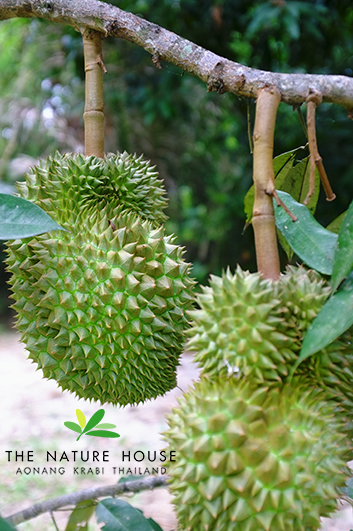
Regarded by many people in southeast Asia as the “king of fruits”, the durian is distinctive for its large size, strong odour, and formidable thorn-covered husk. The fruit can grow as large as 30 centimetres (12 in) long and 15 centimetres (6 in) in diameter, and it typically weighs one to three kilograms (2 to 7 lb). Its shape ranges from oblong to round, the colour of its husk green to brown, and its flesh pale yellow to red, depending on the species.
The edible flesh emits a distinctive odour that is strong and penetrating even when the husk is intact. Some people regard the durian as pleasantly fragrant; others find the aroma overpowering and revolting. The smell evokes reactions from deep appreciation to intense disgust, and has been described variously as almonds, rotten onions, turpentine, raw sewage, and gym socks. The persistence of its odour has led to the fruit’s banishment from certain hotels and public transportation in southeast Asia.
Durian trees are large, growing to 25–50 metres (80–164 ft) in height depending on the species. The leaves are evergreen, elliptic to oblong and 10–18 centimetres (4–7 in) long. The flowers are produced in three to thirty clusters together on large branches and directly on the trunk with each flower having a calyx (sepals) and five (rarely four or six) petals. Durian trees have one or two flowering and fruiting periods per year, although the timing varies depending on the species, cultivars, and localities. A typical durian tree can bear fruit after four or five years. The durian fruit can hang from any branch and matures roughly three months after pollination. The fruit can grow up to 30 centimetres (12 in) long and 15 centimetres (6 in) in diameter, and typically weighs one to three kilograms (2 to 7 lb). Its shape ranges from oblong to round, the colour of its husk green to brown, and its flesh pale-yellow to red, depending on the species.
Health benefits of Durian
Durian Fruit is an exotic, costly, and seasonal fruit that have a rich content of phytonutrients, antioxidant, protein, vitamins and minerals. Durian has high calories and carbohydrate is a good source of energy.
Some of the health benefits associated with the fruit include: •Raises serotonin levels. Creates an over-all sense of well being and aids in despair.
•It has high amount of proteins and amino acids
•Good to building the muscles and organ function
• High in antioxidants
•Anti-aging benefits including enhancing the appearance of your skin.
•It has the most complete nutritional profile of any fruit
•It is power packed with nutrients, including essential fatty acids and organo-sulfur compound
•It gives increased energy, endurance, mental clarity, and cellular health.
•It is Anti-inflammatory, anti-parasitic, Thermogenic, calms fever, aids healing of swelling and skin diseases
• Serotonin causes a calming effect in most individuals; the Kiwifruit contains a relatively high level of serotonin
•enhances libido . . . helps revitalize the desire for sexual intimacy
Mango
Mango trees grow up to 35–40 m (115–130 ft) tall, with a crown radius of 10 m (33 ft). The trees are long-lived, as some specimens still fruit after 300 years. In deep soil, the taproot descends to a depth of 6 m (20 ft), with profuse, wide-spreading feeder roots; the tree also sends down many anchor roots, which penetrate several feet of soil. The leaves are evergreen, alternate, simple, 15–35 cm (5.9–14 in) long and 6–16 cm (2.4–6.3 in) broad; when the leaves are young they are orange-pink, rapidly changing to a dark, glossy red, then dark green as they mature. The flowers are produced in terminal panicles 10–40 cm (3.9–16 in) long; each flower is small and white with five petals 5–10 mm (0.20–0.39 in) long, with a mild, sweet odor suggestive of lily of the valley. The fruit takes three to six months to ripen.
The ripe fruit varies in size and color. Cultivars are variously yellow, orange, red or green, and carry a single flat, oblong pit that can be fibrous or hairy on the surface, and which does not separate easily from the pulp. Ripe, unpeeled mangoes give off a distinctive resinous, sweet smell. Inside the pit 1–2 mm (0.039–0.079 in) thick is a thin lining covering a single seed, 4–7 mm (0.16–0.28 in) long. The seed contains the plant embryo.
The mango is generally sweet, although the taste and texture of the flesh varies across cultivars, some having a soft, pulpy texture similar to an overripe plum, while the flesh of others is firmer, like a cantaloupe or avocado, or may have a fibrous texture. For consumption of unripe, pickled or cooked fruit, the mango skin may be consumed comfortably, but has potential to cause contact dermatitis of the lips, gingiva or tongue in susceptible people (see below). Under-ripe mangoes can be ripened by placing them in brown paper bags. They will then keep in a plastic bag in the refrigerator for about four or five days.In ripe fruits which are commonly eaten fresh, the skin may be thicker and bitter tasting, so is typically not eaten.
Mangoesteen
Fruit description - Mangosteen is a dark purple fruit with white on the inside of the fruit from Southeast-Asia, Thailand being one of its largest producers in the world. Even though mangosteen sounds like a mango type, it is really very different mango. Now it is always available at Asian markets across North America. Mangosteen is delectably sweet and juicy fruit that offers numerous health benefits of both the fruit itself and its skin which are incredibly potent disease fighters. Delicious as it is useful, the mangosteen fruit is always rich in xanthones, which may promote healthy physical function. In addition, mangosteen severing contains up to 5 grams of fiber. Its purplish pigment is also used as a dye.
Taste - Mangosteen is very sweet. The mangosteen has flavors that taste like a combination of strawberry, peach, vanilla ice cream; it is definitely sweet with a very slight sourness. The flavor is divine with durian fruit and wonderfully delicate. The flavor does not even seem to resemble that of the fresh fruit. It has been described as tasting strawberry, peach, and vanilla ice cream. A mangosteen should be eaten as soon as it is opened.
Mangosteen tree and appearance of fruit - Mangosteen fruit grows on a tree with black color, but not just an ordinary tree. Mangosteen trees grow in deep rich soils only, and grow 20 to 80 feet in height. The tree has thick evergreen leaves, and blooms reaching upwards of a foot in width. The bark of the tree is nearly black in color. Fruits are harvested using a ladder or a cutting pole, but are in no way allowed to touch the ground normally. It would damage the fruit. The shell of the Mangosteen fruit looks tough and hard, but is easy to open with hands. Care must be taken when opening the fruit, as the reddish-black husk outside produces a purplish, inky juice that stains fabric and can be almost impossible to remove. To open a Mangosteen, the shell is usually broken apart, not cut. Holding the fruit in both hands, press it until the shell cracks.
Health benefits of Mangosteen
For hundreds of years, the people of Southeast Asia have been using the Mangosteen, especially the rind called the pericarp, to ward-off and treat infections, reduce pain or control fever, and treat various other ailments. Dried Mangosteen fruits are transported from Singapore to Calcutta and to China for medicinal use. The sliced and dried pericarp is powdered and managed to overcome dysentery. Made into an ointment, it is applied on eczema and other skin disorders.
